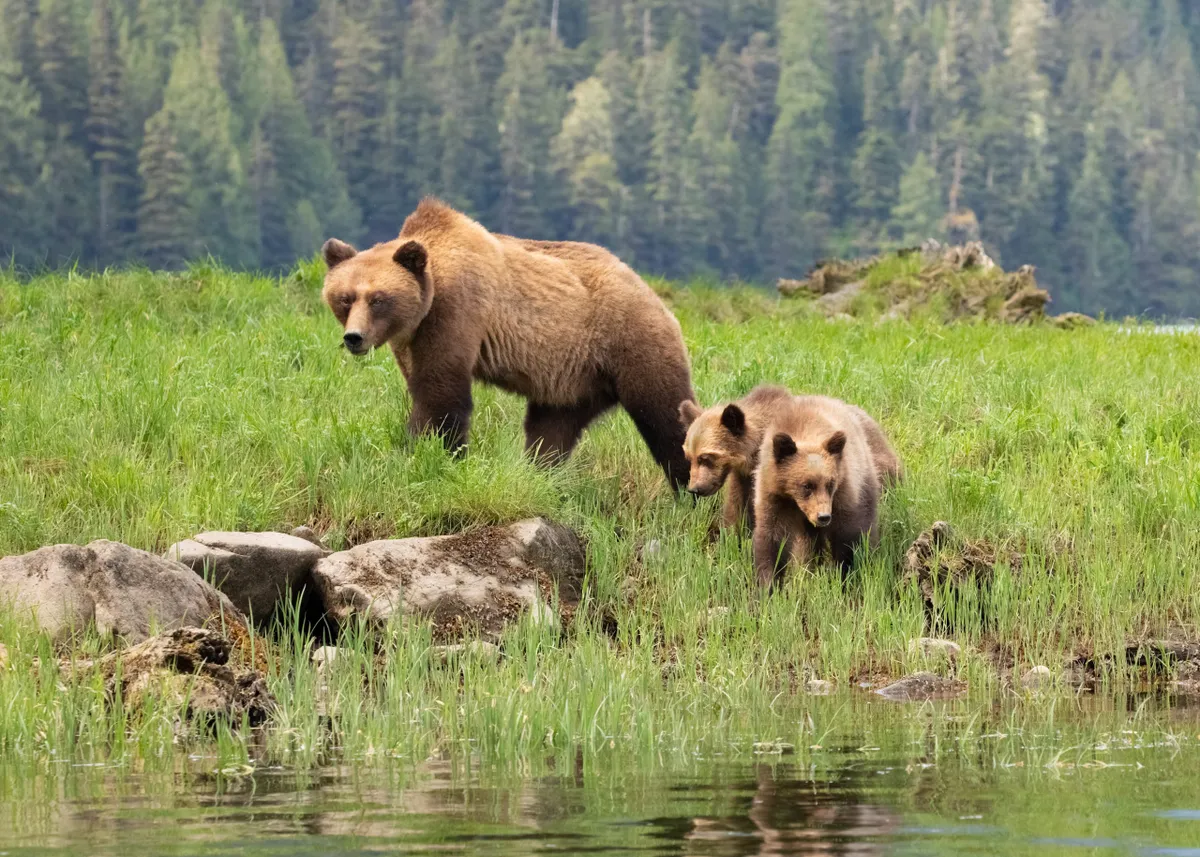Grizzly bears hunting during the annual salmon run in North America has to be one of nature’s greatest spectacles. But there is much more to this species – the grizzly bear is both a skilled hunter and a resourceful forager, a coastal creature and forest dweller.
Find out more in our expert grizzly bear guide, including where to see in the wild, their diet and how they hunt and conservation efforts.
Are grizzly bears the same as brown bears?
Grizzly bears (Ursus arctos horribilis) are a subspecies of brown bear (Ursus arctos) found only in North America. People often refer to those animals that live inland as grizzly bears and those that live along the coast as brown bears; however, the name ‘grizzly’ can encompass both.
Where can you find grizzly bears?
Grizzly bears are able to live in a great range of habitats across North America – in fact, they occupy a wider diversity of habitats than any other species of bear, from woodlands and forests to alpine meadows and prairies. The bears prefer access to coastal areas, rivers and streams.

If you want to see a grizzly bear, one of the best places to head to is the wilds of Canada, which alone has an estimated 25,000 grizzlies – over half of which live in British Columbia. The Great Bear Rainforest, Khutzeymateen Grizzly Sanctuary and Knight Inlet all offer fantastic bear viewing.
- How to identify animal droppings
- Wildlife of the Canadian Rockies
- A year in the life of European brown bears
Alaska is also a stronghold, and you can still find small populations within the north-west of the USA, including Washington State, Montana, Idaho and Wyoming. Conservation efforts have seen grizzlies recovering in Yellowstone National Park, which has over 500 individuals.
When is the best time to see grizzly bears?
Come to North America in summer and autumn, and you can witness the most exciting time of year in the grizzlies’ calendar – the famous salmon run! Each year, the salmon battle their way up the river systems to their native spawning grounds, sparking a feasting frenzy for hungry bears.
What do grizzly bears eat?
Grizzly bears are resourceful omnivores and will forage on whatever is available, including grasses, herbs, roots, berries, nuts, rodents and insects. Grizzly bears tend to be more carnivorous in the Arctic, where ungulates are abundant, and of course in coastal areas when spawning salmon are available.

How do grizzly bears hunt?
Though grizzly bears are largely vegetarian, they are powerful apex predators. The bears have a keen sense of smell (better than a dog’s) and are able to sprint up to 55km per hour over short distances, allowing them to take down young or weakened caribou, deer and elk. Grizzlies can use their claws (which grow up to 10 cm in length) to dig out underground rodents, and catch salmon in mid-air or pin them to the riverbed – grizzlies are very adept at fishing.
Are grizzly bears dangerous?
Grizzly bears generally try to avoid people, but are more likely to attack when protecting their young, when surprised, or when disturbed during hibernation. It is advised that hikers carry bear spray (a type of pepper spray) and back away slowly – a grizzly bear will easily outrun you.

When do grizzly bears hibernate?
During wintertime, grizzly bears can be found in their dens, often excavated at the base of trees or in caves on north-facing slopes, which will receive the most snowfall and therefore offer the best protective cover. Technically, they enter a deep sleep rather than hibernation.
When is grizzly-bear breeding season?
From May to July, grizzly bears will be looking for a mate to reproduce with. Although a female might be impregnated, the embryo will not begin to develop until she enters her winter hibernation. Cubs are usually born in January or February. They are cared for within the den before emerging in spring.

Are grizzly bears endangered?
The IUCN classes the brown bear as being of ‘Least Concern’. There are estimated to be 200,000 individuals worldwide, with 33,000 in the USA and 25,000 in Canada. Nonetheless, in the USA and Canada populations are threatened by human development and habitat loss, as well as where hunting occurs at unsustainable rates.
How can we protect grizzly bears?
Conservation efforts are focused on helping human-grizzly co-existence and conflict reduction (e.g. through the use of electric fencing and locked bins), minimising the fragmentation of bear habitat and controlling hunting activity.
In parts of the U.S., small populations of grizzly bears have increased under the protection of the Endangered Species Act, and the hunting of grizzly bears is banned in British Columbia.
Main image: Grizzly bear photographed in Jasper, Canada/ Credit: Getty

